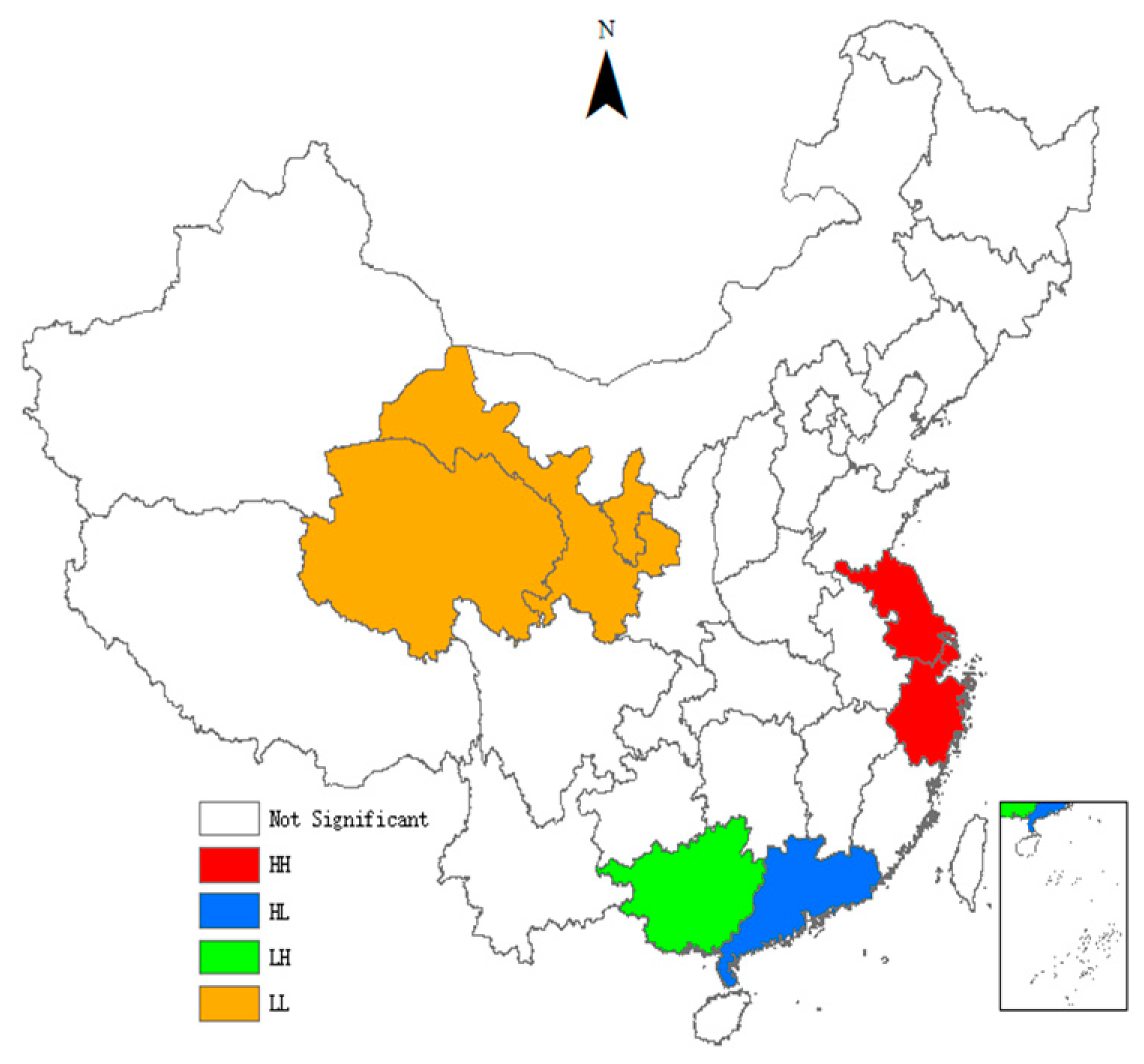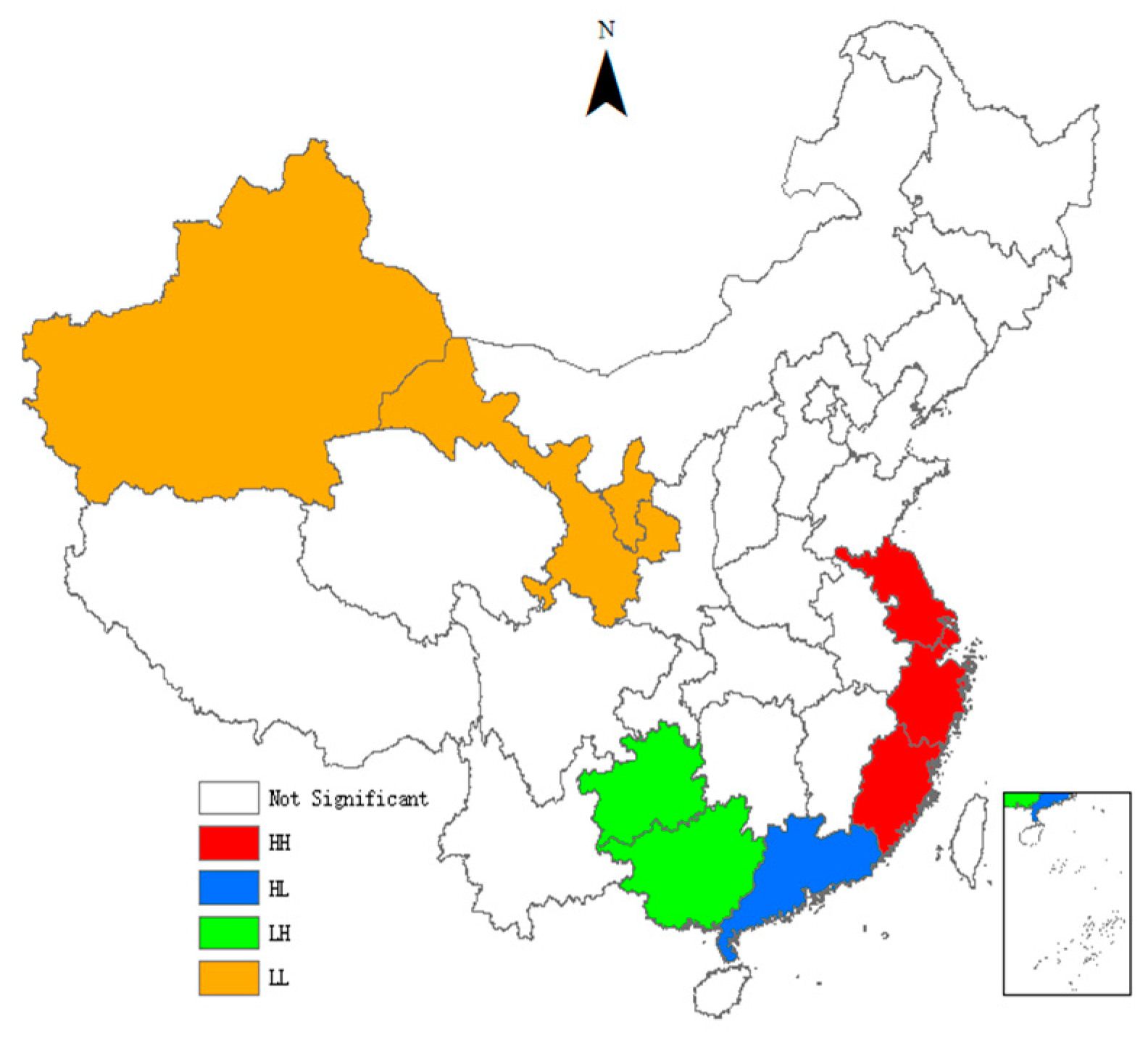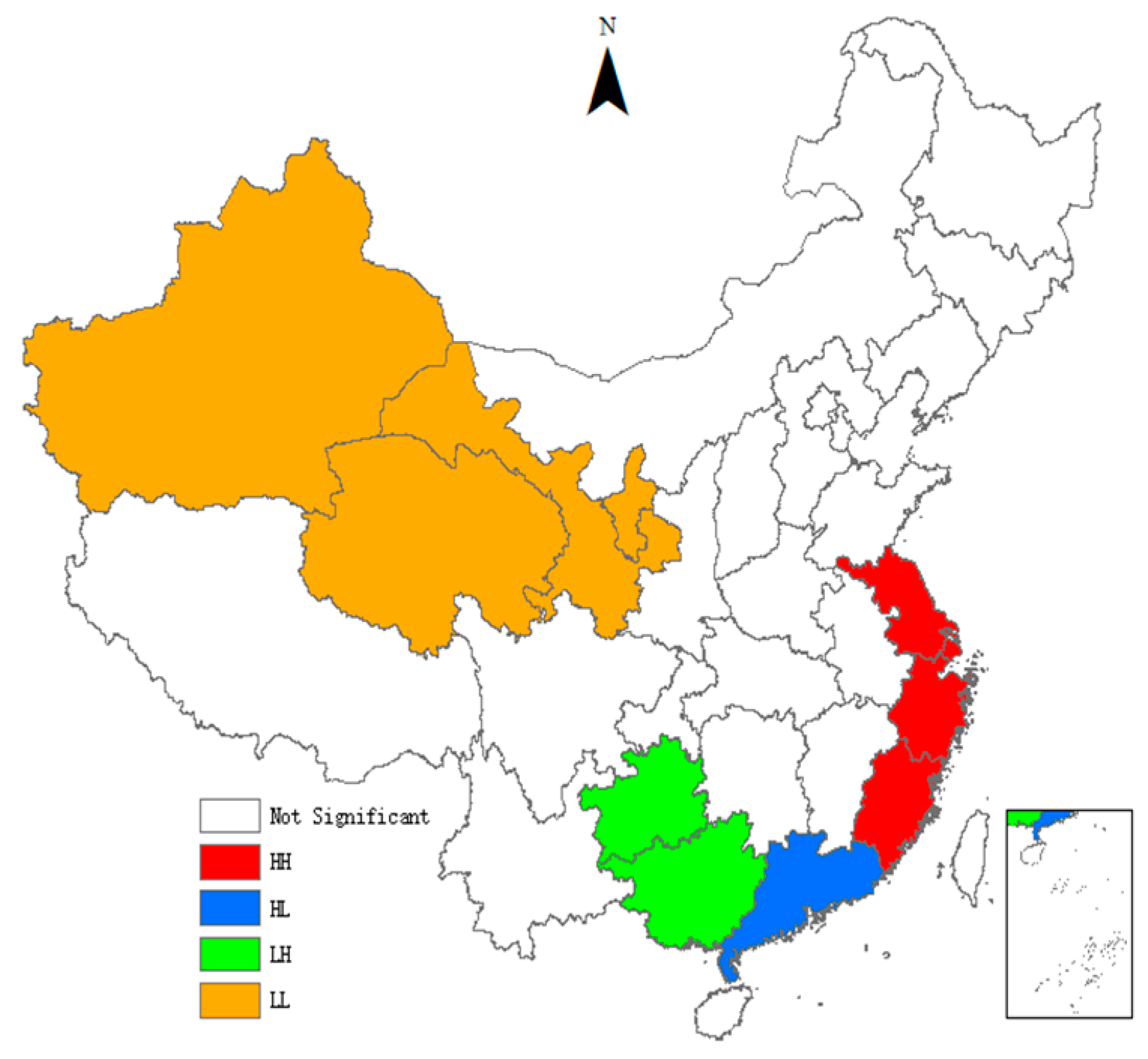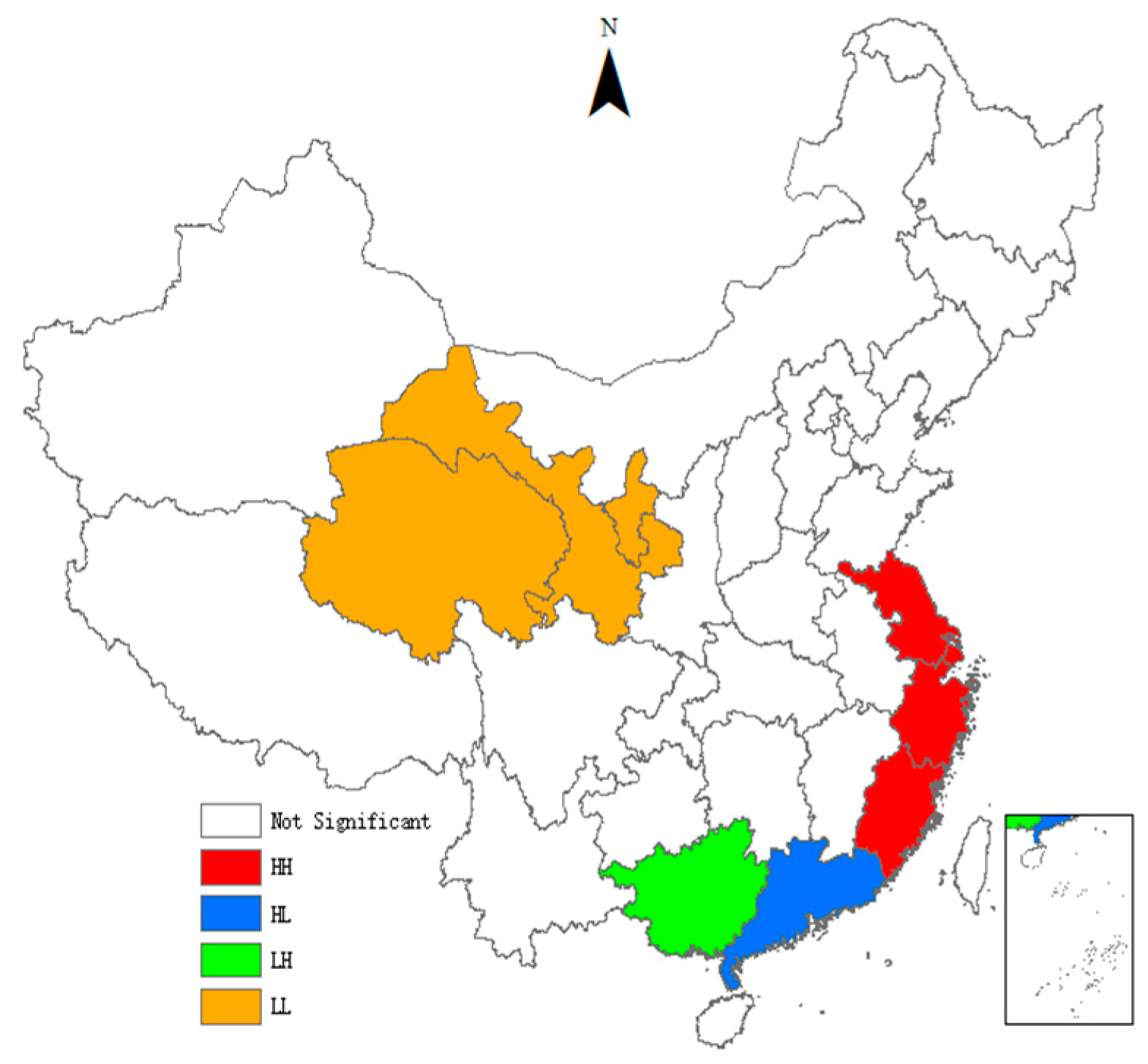Can Industrial Structural Adjustment Improve the Total-Factor Carbon Emission Performance in China?
Abstract
:1. Introduction
2. Literature Review
3. Materials and Methods
3.1. Dynamic Spatial Panel Model
3.2. Variable Description and Data Sources
3.2.1. Explained Variable: Industrial Total-Factor Carbon Emission Performance (TCPI)
3.2.2. Core Explanatory Variables: Industrial Structure (Str)
3.2.3. Control Variables
4. Results
4.1. The Meta-Frontier Total-Factor Carbon Emission Performance Since the 21st Century
4.2. Spatial Auto-Correlation Tests
5. Discussion
5.1. Analysis of Regression Results at the National Level
5.2. Analysis of Regression Results at the Regional Level
5.3. Robustness Test
6. Conclusions
Author Contributions
Funding
Conflicts of Interest
References
- Zhang, N.; Wei, X. Dynamic total factor carbon emissions performance changes in the Chinese transportation industry. Appl. Energy 2015, 146, 409–420. [Google Scholar] [CrossRef]
- Cheng, Z.H.; Li, L.S.; Liu, J.; Zhang, H.M. Total-factor carbon emission efficiency of China’s provincial industrial sector and its dynamic evolution. Renew. Sustain. Energy Rev. 2018, 94, 330–339. [Google Scholar] [CrossRef]
- Chenery, H. Interregional and international input-output analysis. In The Structural Interdependence of the Economy; John Wiley & Sons: New York, NY, USA, 1956; pp. 339–357. [Google Scholar]
- Li, K.; Lin, B.Q. Economic growth model, structural transformation, and green productivity in China. Appl. Energy 2017, 187, 489–500. [Google Scholar] [CrossRef]
- Grossman, G.M.; Krueger, A.B. Economic growth and the environment. Q. J. Econ. 1995, 110, 353–377. [Google Scholar] [CrossRef]
- Brock, W.A.; Taylor, M.S. Economic growth and the environment: A review of theory and empirics. In Handbook of Economic Growth; Elsevier: Amsterdam, The Netherlands, 2005; Volume 1, pp. 1749–1821. [Google Scholar]
- Gill, A.R.; Viswanathan, K.K.; Hassan, S. The environmental Kuznets Curve (EKC) and the environmental problem of the day. Renew. Sustain. Energy Rev. 2018, 81, 1636–1642. [Google Scholar] [CrossRef]
- Liu, N.; Ma, Z.J.; Kang, J.D. Changes in carbon intensity in China’s industrial sector: Decomposition and attribution analysis. Energy Policy 2015, 87, 28–38. [Google Scholar] [CrossRef]
- Zhang, W.; Li, K.; Zhou, D.Q.; Zhang, W.R.; Gao, H. Decomposition of intensity of energy-related CO2 emission in Chinese provinces using the LMDI method. Energy Policy 2016, 92, 369–381. [Google Scholar] [CrossRef]
- Dong, F.; Li, J.Y.; Zhang, Y.J.; Wang, Y. Drivers analysis of CO2 emissions from the perspective of carbon intensity: The case of Shandong province, China. Int. J. Environ. Res. Public Health 2018, 15, 1762. [Google Scholar] [CrossRef] [PubMed]
- Mi, Z.F.; Meng, J.; Guan, D.B.; Shan, Y.; Song, M.; Wei, Y.-M.; Liu, Z.; Hubacek, K. Chinese CO2 emission flows have reversed since the global financial crisis. Nat. Commun. 2017, 8, 1712. [Google Scholar] [CrossRef] [PubMed]
- Wang, H.; Ang, B.W.; Su, B. Multiplicative structural decomposition analysis of energy and emission intensities: Some methodological issues. Energy 2017, 123, 47–63. [Google Scholar] [CrossRef]
- Mi, Z.F.; Meng, J.; Green, F.; Coffman, D.M.; Guan, D. China’s “Exported Carbon” peak: Patterns, drivers, and implications. Geophys. Res. Lett. 2018, 45, 4309–4318. [Google Scholar] [CrossRef]
- Mi, Z.F.; Pan, S.Y.; Yu, H.; Wei, Y.M. Potential impacts of industrial structure on energy consumption and CO2 emission: A case study of Beijing. J. Clean. Prod. 2015, 103, 455–462. [Google Scholar] [CrossRef]
- Mi, Z.F.; Wei, Y.M.; Wang, B.; Meng, J.; Liu, Z.; Shan, Y.; Liu, J.; Guan, D. Socioeconomic impact assessment of China’s CO2 emission peak prior to 2030. J. Clean. Prod. 2017, 142, 2227–2236. [Google Scholar] [CrossRef]
- Fan, Y.; Liu, L.C.; Wu, G.; Tsai, H.T.; Wei, Y.M. Changes in carbon intensity in China: Empirical findings from 1980–2003. Ecol. Econ. 2007, 62, 683–691. [Google Scholar] [CrossRef]
- Zhang, Y.G. Structural decomposition analysis of sources of decarbonizing economic development in China; 1992–2006. Ecol. Econ. 2009, 68, 2399–2405. [Google Scholar] [CrossRef]
- Yi, B.W.; Xu, J.H.; Fan, Y. Determining factors and diverse scenarios of CO2 emissions intensity reduction to achieve the 40–45% target by 2020 in China-a historical and perspective analysis for the period 2005–2020. J. Clean. Prod. 2016, 122, 87–101. [Google Scholar] [CrossRef]
- Wang, H.; Ang, B.W.; Su, B. A Muti-region structural decomposition analysis of global CO2 emission intensity. Ecol. Econ. 2017, 142, 163–176. [Google Scholar] [CrossRef]
- Tan, Z.F.; Li, L.; Wang, J.J.; Wang, J.H. Examining the driving forces for improving China’s CO2 emission intensity using the decomposing method. Appl. Energy 2011, 88, 4496–4504. [Google Scholar] [CrossRef]
- Gonzalez, D.; Martinez, M. Changes in CO2 emission intensities in the Mexican Industry. Energy Policy 2012, 51, 149–163. [Google Scholar] [CrossRef]
- Xu, B.; Lin, B.Q. Regional differences of pollution emissions in China: Contributing factors and mitigation strategies. J. Clean. Prod. 2016, 112, 1454–1463. [Google Scholar] [CrossRef]
- Xu, B.; Luo, L.Q.; Lin, B.Q. A dynamic analysis of air pollution emissions in China: Evidence from nonparametric additive regression models. Ecol. Indic. 2016, 63, 346–358. [Google Scholar] [CrossRef]
- Sheng, J.C.; Zhang, S.; Li, Y. Heterogeneous governance capabilities, reference emission levels and emissions from deforestation and degradation: A signaling model approach. Land Use Policy 2017, 64, 124–132. [Google Scholar] [CrossRef]
- Zheng, X.Y.; Yu, Y.H.; Wang, J.; Deng, H.H. Identifying the determinants and spatial nexus of provincial carbon intensity in China: A dynamic spatial panel approach. Reg. Environ. Chang. 2014, 14, 1651–1661. [Google Scholar] [CrossRef]
- Yang, Y.; Cai, W.J.; Wang, C. Industrial CO2 intensity, indigenous innovation and R&D spillovers in China’s provinces. Appl. Energy 2014, 131, 117–127. [Google Scholar]
- Zhao, X.T.; Burnett, J.W.; Fletcher, J.J. Spatial analysis of China province-level CO2 emission intensity. Renew. Sustain. Energy Rev. 2014, 33, 1–10. [Google Scholar] [CrossRef]
- Wang, Z.H.; Zhang, B.; Liu, T.F. Empirical analysis on the factors influencing national and regional carbon intensity in China. Renew. Sustain. Energy Rev. 2016, 55, 34–42. [Google Scholar] [CrossRef]
- Long, R.Y.; Shao, T.X.; Chen, H. Spatial econometric analysis of China’s province-level industrial carbon productivity and its influencing factors. Appl. Energy 2016, 166, 210–219. [Google Scholar] [CrossRef]
- Cheng, Z.H.; Li, L.S.; Liu, J. Industrial structure, technical progress and carbon intensity in China’s provinces. Renew. Sustain. Energy Rev. 2018, 81, 2935–2946. [Google Scholar] [CrossRef]
- Yao, X.; Guo, C.W.; Shao, S.; Jiang, Z.J. Total-factor CO2 emission performance of China’s provincial industrial sector: A meta-frontier non-radial Malmquist index approach. Appl. Energy 2016, 184, 1142–1153. [Google Scholar] [CrossRef]
- Hu, J.F.; Wang, Z.; Lian, Y.H.; Huang, Q.H. Environmental regulation, foreign direct investment and green technological progress-Evidence from Chinese manufacturing industries. Int. J. Environ. Res. Public Health 2018, 15, 221. [Google Scholar] [CrossRef]
- Wang, Y.; Shen, N. Environmental regulation and environmental productivity: The case of China. Renew. Sustain. Energy Rev. 2016, 62, 758–766. [Google Scholar] [CrossRef]
- Oh, D.H. A metafrontier approach for measuring an environmentally sensitive productivity growth index. Energy Econ. 2010, 32, 146–157. [Google Scholar] [CrossRef]
- Oh, D.H.; Lee, J.D. A metafrontier approach for measuring Malmquist productivity index. Empir. Econ. 2010, 38, 47–64. [Google Scholar] [CrossRef]
- Zhang, N.; Choi, Y. Total-factor carbon emission performance of fossil fuel power plants in china: A metafrontier non-radial malmquist index analysis. Energy Econ. 2013, 40, 549–559. [Google Scholar] [CrossRef]
- Nabavieh, A.; Gholamiangonabadi, D.; Ahangaran, A.A. Dynamic changes in CO2 emission performance of different types of Iranian fossil-fuel power plants. Energy Econ. 2015, 52, 142–150. [Google Scholar] [CrossRef]
- Wang, Q.W.; Su, B.; Zhou, P.; Chiu, C.R. Measuring total-factor CO2, emission performance and technology gaps using a non-radial directional distance function: A modified approach. Energy Econ. 2016, 56, 475–482. [Google Scholar] [CrossRef]
- Wang, Q.W.; Chiu, Y.H.; Chiu, C.R. Non-radial metafrontier approach to identify carbon emission performance and intensity. Renew. Sustain. Energy Rev. 2017, 69, 664–672. [Google Scholar] [CrossRef]
- Young, A. Gold into base metals: Productivity growth in the People’s Republic of China during the Reform Period. J. Political Econ. 2003, 111, 1220–1261. [Google Scholar] [CrossRef]
- Cheng, Z.H.; Li, L.S.; Liu, J. Identifying the spatial effects and driving factors of urban PM2.5 pollution in China. Ecol. Indic. 2017, 82, 61–75. [Google Scholar] [CrossRef]
- Elhorst, J.P. Unconditional maximum likelihood estimation of linear and log-linear dynamic models for spatial panels. Geogr. Anal. 2005, 37, 62–83. [Google Scholar] [CrossRef]
- Kukenova, M.; Monteiro, J. Spatial Dynamic Panel Model and System GMM: A Monte Carlo Investigation; IRENE Working Papers 09-01; Irene Institute of Economic Research: Munich, Germany, 2009. [Google Scholar]
- Jacobs, J.P.A.M.; Ligthart, J.E.; Vrijburg, H. Dynamic Panel Data Models Featuring Endogenous Interaction and Spatially Correlated Errors; International Center for Public Policy Working Paper Series 0915; Georgia State University: Atlanta, GA, USA, 2009. [Google Scholar]




| Variable | Region | Mean | Std. Dev. | Min | Max |
|---|---|---|---|---|---|
| Capital (Unit: 100 million Yuan) | Whole China | 15,519.26 | 17,826.92 | 394.84 | 107,061.70 |
| Eastern China | 25,544.24 | 23,773.77 | 394.84 | 107,061.70 | |
| Central China | 12,402.87 | 10,284.41 | 1835.97 | 55,710.97 | |
| Western China | 7760.75 | 7693.80 | 511.12 | 40,401.38 | |
| Labor (Unit: Ten thousand) | Whole China | 263.24 | 288.06 | 9.62 | 1568.00 |
| Eastern China | 452.44 | 384.17 | 9.62 | 1568.00 | |
| Central China | 226.40 | 118.64 | 95.72 | 717.31 | |
| Western China | 100.83 | 76.13 | 13.48 | 397.81 | |
| Energy (Unit: Ten thousand tons of standard coal) | Whole China | 3085.38 | 2444.94 | 119.94 | 13,237.40 |
| Eastern China | 3797.53 | 3331.51 | 119.94 | 13,237.40 | |
| Central China | 3416.13 | 1689.31 | 782.44 | 7875.37 | |
| Western China | 2132.68 | 1299.62 | 201.43 | 5946.91 | |
| Desirable output (Unit: 100 million Yuan) | Whole China | 17,368.34 | 24,773.01 | 174.75 | 147,074.50 |
| Eastern China | 30,892.18 | 34,044.71 | 174.75 | 147,074.50 | |
| Central China | 14,075.54 | 14,367.16 | 896.87 | 73,365.96 | |
| Western China | 6239.27 | 7283.45 | 195.74 | 38,645.91 | |
| Undesirable output (Unit: Ten thousand tons) | Whole China | 8382.44 | 6970.77 | 242.36 | 38,938.67 |
| Eastern China | 10,412.24 | 9593.46 | 242.36 | 38,938.67 | |
| Central China | 9424.87 | 4791.35 | 2197.16 | 21,735.77 | |
| Western China | 5594.50 | 3398.83 | 493.55 | 14,494.58 |
| Variable | Obs | Mean | Std. Dev. | Min | Max |
|---|---|---|---|---|---|
| TCPI | 450 | 1.139 | 0.300 | 0.503 | 2.191 |
| IS | 450 | 1.204 | 1.739 | 0.137 | 3.584 |
| LH | 450 | 74.479 | 10.701 | 42.376 | 95.684 |
| SC | 450 | 68.898 | 9.684 | 35.526 | 88.029 |
| OW | 450 | 45.501 | 20.696 | 10.069 | 90.142 |
| EN | 450 | 72.391 | 51.715 | 16.779 | 349.599 |
| ECS | 450 | 80.271 | 15.939 | 20.812 | 97.617 |
| FDI | 450 | 19.550 | 16.900 | 1.122 | 65.640 |
| Tech | 450 | 156.367 | 238.300 | 0.630 | 1520.550 |
| Env | 450 | 16.089 | 12.906 | 0.695 | 104.815 |
| Group | Provinces | TCPI | EC | BPC | TGC |
|---|---|---|---|---|---|
| East | Beijing | 1.2064 | 1.0555 | 1.1552 | 1.0000 |
| East | Tianjin | 1.1827 | 1.0545 | 1.1513 | 1.0000 |
| East | Hebei | 1.1685 | 1.0491 | 1.1233 | 0.9946 |
| East | Liaoning | 1.1241 | 1.0158 | 1.1215 | 0.9864 |
| East | Shanghai | 1.1366 | 0.9995 | 1.1373 | 1.0000 |
| East | Jiangsu | 1.1632 | 1.0125 | 1.1406 | 1.0147 |
| East | Zhejiang | 1.1197 | 0.9762 | 1.1472 | 1.0000 |
| East | Fujian | 1.1495 | 1.0309 | 1.1293 | 1.0000 |
| East | Shandong | 1.1607 | 1.0666 | 1.1373 | 0.9938 |
| East | Guangdong | 1.1344 | 1.0000 | 1.1368 | 0.9979 |
| East | Hainan | 1.1301 | 1.0043 | 1.1255 | 1.0000 |
| Central | Shanxi | 1.1558 | 1.0433 | 1.1215 | 0.9783 |
| Central | Jilin | 1.1584 | 1.0488 | 1.1302 | 0.9799 |
| Central | Heilongjiang | 1.0605 | 0.9511 | 1.1165 | 0.9872 |
| Central | Anhui | 1.1747 | 1.0781 | 1.1209 | 0.9755 |
| Central | Jiangxi | 1.1893 | 1.0594 | 1.1211 | 1.0044 |
| Central | Henan | 1.1220 | 1.0007 | 1.1512 | 0.9758 |
| Central | Hubei | 1.1435 | 1.1014 | 1.1607 | 0.9735 |
| Central | Hunan | 1.1632 | 1.0397 | 1.1127 | 0.9938 |
| West | Inner Mongolia | 1.1286 | 1.0621 | 1.1897 | 0.9578 |
| West | Guangxi | 1.1588 | 1.0399 | 1.1780 | 1.0048 |
| West | Chongqing | 1.2257 | 1.0364 | 1.1644 | 1.0274 |
| West | Sichuan | 1.1508 | 0.9902 | 1.1427 | 1.0261 |
| West | Guizhou | 1.1653 | 1.0085 | 1.1452 | 1.0306 |
| West | Yunnan | 1.0674 | 0.9509 | 1.1414 | 1.0114 |
| West | Shaanxi | 1.0809 | 0.9694 | 1.1248 | 1.0175 |
| West | Gansu | 1.0822 | 1.0207 | 1.1209 | 0.9800 |
| West | Qinghai | 1.0225 | 0.9270 | 1.1353 | 0.9817 |
| West | Ningxia | 1.1969 | 1.0141 | 1.1507 | 1.0274 |
| West | Xinjiang | 1.0454 | 0.9392 | 1.1436 | 0.9943 |
| Eastern China | 1.1524 | 1.0241 | 1.1368 | 0.9988 | |
| Central China | 1.1459 | 1.0403 | 1.1294 | 0.9836 | |
| Western China | 1.1204 | 0.9962 | 1.1488 | 1.0054 | |
| Whole China | 1.1389 | 1.0181 | 1.1392 | 0.9972 |
| Year | 2000–2001 | 2001–2002 | 2002–2003 | 2003–2004 | 2004–2005 |
| Moran’s I | 0.114 * | 0.163 ** | 0.165 ** | 0.191 *** | 0.225 *** |
| [1.723] | [2.293] | [2.303] | [2.647] | [3.061] | |
| Year | 2005–2006 | 2006–2007 | 2007–2008 | 2008–2009 | 2009–2010 |
| Moran’s I | 0.269 *** | 0.271 *** | 0.287 *** | 0.344 *** | 0.265 *** |
| [3.571] | [3.591] | [3.793] | [4.491] | [3.557] | |
| Year | 2010–2011 | 2011–2012 | 2012–2013 | 2013–2014 | 2014–2015 |
| Moran’s I | 0.256 *** | 0.236 *** | 0.220 *** | 0.212 *** | 0.211 *** |
| [3.401] | [3.186] | [3.002] | [2.871] | [2.864] |
| Type | Ordinary Static Panel Model (1) | Ordinary Dynamic Panel Model (2) | Static Spatial Panel Model (3) | Dynamic Spatial Panel Model (4) |
|---|---|---|---|---|
| (dynamic factor) | 0.216 *** | 0.102 *** | ||
| [3.84] | [4.37] | |||
| (spatial factor) | 0.621 *** | 0.003 *** | ||
| [9.27] | [3.34] | |||
| lnIS | −0.035 *** | −0.029 *** | −0.047 *** | −0.043 *** |
| [−3.53] | [−3.14] | [−3.43] | [−3.78] | |
| lnLH | −0.128 | −0.113 * | −0.092 | −0.106 *** |
| [−1.10] | [−1.70] | [−1.17] | [−2.93] | |
| lnSC | 0.061 | 0.067 | 0.055 * | 0.053 ** |
| [0.82] | [1.28] | [1.77] | [2.05] | |
| lnOW | −0.021 | −0.011 | −0.032 | −0.025 |
| [−0.49] | [−0.87] | [−0.94] | [−1.06] | |
| lnEN | −0.056 ** | −0.054 *** | −0.057 *** | −0.048 *** |
| [−2.32] | [−3.43] | [−3.72] | [−3.60] | |
| lnECS | −0.085 * | −0.092 * | −0.104 *** | −0.085 *** |
| [−1.79] | [−1.74] | [−2.79] | [−3.52] | |
| lnFDI | 0.023 | 0.040 | 0.062 | 0.036 |
| [1.14] | [1.27] | [1.31] | [1.05] | |
| lnTech | 0.040 *** | 0.045 *** | 0.024 *** | 0.027 *** |
| [5.87] | [5.24] | [5.38] | [5.61] | |
| lnEnv | 0.024 | 0.026 * | 0.036 ** | 0.035 ** |
| [1.21] | [1.83] | [1.99] | [2.21] | |
| Cons | −0.502 *** | −1.224 *** | −0.342 *** | −0.154 *** |
| [−2.98] | [−3.46] | [−4.65] | [−4.18] | |
| Obs | 450 | 420 | 450 | 420 |
| LogL | 123.736 | 150.285 | 174.363 | |
| LM-Lag test | (0.023) | (0.028) | ||
| Robust LM-Lag test | (0.054) | (0.070) | ||
| LM-Error test | (0.130) | (0.128) | ||
| Robust LM-Error test | (0.159) | (0.157) | ||
| Hausman test | (0.001) | (0.000) | (0.000) | |
| System GMM test AR(1) test | (0.000) | (0.000) | ||
| AR(2) test | (0.252) | (0.233) | ||
| Hansen over-identification test | (1.000) | (1.000) |
| Region | The Eastern China | The Central China | The Western China |
|---|---|---|---|
| (dynamic factor) | 0.128 *** | 0.107 *** | 0.095 *** |
| [5.13] | [4.52] | [3.87] | |
| (spatial factor) | 0.007 *** | 0.005 *** | 0.002 *** |
| [3.78] | [3.36] | [3.13] | |
| lnIS | −0.043 ** | −0.057 *** | −0.049 *** |
| [−2.13] | [−3.95] | [−3.18] | |
| lnLH | −0.119 *** | −0.123 *** | −0.104 *** |
| [−3.07] | [−3.29] | [−2.76] | |
| lnSC | 0.048 *** | 0.064 ** | 0.060 |
| [2.44] | [2.15] | [1.37] | |
| lnOW | 0.025 | 0.016 * | 0.032 |
| [0.71] | [1.77] | [0.81] | |
| lnEN | 0.013 * | −0.047 *** | −0.079 *** |
| [1.75] | [−3.68] | [−3.97] | |
| lnECS | −0.084 *** | −0.061 *** | −0.074 *** |
| [−3.07] | [−3.92] | [−3.59] | |
| lnFDI | 0.025 | 0.045 | −0.011 * |
| [0.88] | [1.16] | [−1.77] | |
| lnTech | 0.042 *** | 0.030 *** | 0.012 *** |
| [6.37] | [5.68] | [4.35] | |
| lnEnv | 0.049 *** | 0.033 ** | 0.025 ** |
| [3.42] | [2.35] | [2.04] | |
| Cons | −0.141 *** | −0.169 *** | −0.157 *** |
| [−3.43] | [−4.64] | [−4.50] | |
| Obs | 154 | 112 | 154 |
| LogL | 73.335 | 51.274 | 69.208 |
| LM-Lag test | (0.023) | (0.027) | (0.019) |
| Robust LM-Lag test | (0.048) | (0.066) | (0.040) |
| LM-Error test | (0.130) | (0.149) | (0.098) |
| Robust LM-Error test | (0.152) | (0.181) | (0.116) |
| Hausman test | (0.001) | (0.000) | (0.001) |
| System GMM test AR(1) test | (0.013) | (0.020) | (0.018) |
| AR(2) test | (0.248) | (0.281) | (0.273) |
| Type | The Whole China | The Eastern China | The Central China | The Western China |
|---|---|---|---|---|
| (dynamic factor) | 0.104 *** | 0.125 *** | 0.108 *** | 0.095 *** |
| [4.53] | [5.17] | [4.28] | [3.62] | |
| (spatial factor) | 0.005 *** | 0.007 *** | 0.004 *** | 0.001 *** |
| [3.63] | [4.08] | [3.26] | [2.86] | |
| lnIS | −0.045 *** | −0.043 ** | −0.056 *** | −0.047 *** |
| [−3.86] | [−2.15] | [−3.87] | [−3.24] | |
| lnLH | −0.104 *** | −0.119 *** | −0.120 *** | −0.097 *** |
| [−2.92] | [−3.16] | [−3.38] | [−2.73] | |
| lnSC | 0.051 ** | 0.048 *** | 0.059 * | 0.052 |
| [2.03] | [2.45] | [1.76] | [1.24] | |
| lnOW | −0.023 | 0.026 | 0.015 * | 0.030 |
| [−1.22] | [0.64] | [1.74] | [0.69] | |
| lnEN | −0.051 *** | 0.014 * | −0.048 *** | −0.072 *** |
| [−3.74] | [1.73] | [−3.67] | [−4.05] | |
| lnECS | −0.085 *** | −0.098 *** | −0.083 *** | −0.062 *** |
| [−3.52] | [−3.27] | [−4.06] | [−3.71] | |
| lnFDI | 0.035 | 0.024 | 0.050 | −0.009 * |
| [1.17] | [0.73] | [1.08] | [−1.74] | |
| lnTech | 0.025 *** | 0.043 *** | 0.028 *** | 0.011 *** |
| [5.52] | [6.31] | [5.60] | [4.18] | |
| lnEnv | 0.034 ** | 0.048 *** | 0.027 ** | 0.020 * |
| [2.19] | [3.22] | [2.21] | [1.78] | |
| Cons | −0.179 *** | −0.130 *** | −0.169 *** | −0.141 *** |
| [−4.24] | [−3.47] | [−4.82] | [−4.37] | |
| Obs | 420 | 154 | 112 | 154 |
| LogL | 174.236 | 71.073 | 51.685 | 67.963 |
| LM-Lag test | (0.026) | (0.026) | (0.027) | (0.020) |
| Robust LM-Lag test | (0.068) | (0.053) | (0.065) | (0.042) |
| LM-Error test | (0.124) | (0.135) | (0.147) | (0.099) |
| Robust LM-Error test | (0.150) | (0.157) | (0.176) | (0.118) |
| Hausman test | 0.000) | (0.001) | (0.000) | (0.001) |
| System GMM test AR(1) test | 0.000) | (0.016) | (0.021) | (0.021) |
| AR(2) test | (0.228) | (0.253) | (0.285) | (0.283) |
| Hansen over-identification test | (1.000) | (1.000) | (1.000) | (1.000) |
© 2018 by the authors. Licensee MDPI, Basel, Switzerland. This article is an open access article distributed under the terms and conditions of the Creative Commons Attribution (CC BY) license (http://creativecommons.org/licenses/by/4.0/).
Share and Cite
Cheng, Z.; Shi, X. Can Industrial Structural Adjustment Improve the Total-Factor Carbon Emission Performance in China? Int. J. Environ. Res. Public Health 2018, 15, 2291. https://doi.org/10.3390/ijerph15102291
Cheng Z, Shi X. Can Industrial Structural Adjustment Improve the Total-Factor Carbon Emission Performance in China? International Journal of Environmental Research and Public Health. 2018; 15(10):2291. https://doi.org/10.3390/ijerph15102291
Chicago/Turabian StyleCheng, Zhonghua, and Xiai Shi. 2018. "Can Industrial Structural Adjustment Improve the Total-Factor Carbon Emission Performance in China?" International Journal of Environmental Research and Public Health 15, no. 10: 2291. https://doi.org/10.3390/ijerph15102291
APA StyleCheng, Z., & Shi, X. (2018). Can Industrial Structural Adjustment Improve the Total-Factor Carbon Emission Performance in China? International Journal of Environmental Research and Public Health, 15(10), 2291. https://doi.org/10.3390/ijerph15102291





